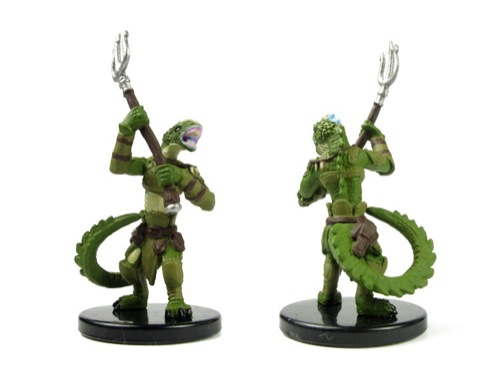Apologies for any disjointedness apparent in this post; this is coming straight from my brain to the rich-text composer. (A "gonzo" post, as some might say.)
Thinking back to my adventures with Sradan, I started remembering my other ideas for having a non-traditional player character at my command. Mostly, this is due to a wish to avoid sameness among the members of a party. Playing 3.5e or Pathfinder (and, from what I've read in the Basic Rules, 5e as well), this is less of a problem, due to the proliferation of previously "optional" classes, and the removal of demihuman class and level restrictions.
 |
| The Lizard Man as he appears in the AD&D 2nd Edition Monstrous Manual. |
The early editions of D&D had some of this built in: in Holmes' D&D book, dwarves and halflings are explicitly stated to always be fighters, and elves to progress as a kind of split-classed fighter/magic-user (although race-as-class of the kind used in B/X and BECMI wasn't implemented - the class restrictions for demihumans were just really strict). Interestingly enough, though, there seems to have been some expectation even at this early stage of unusually creative players:
At the Dungeon Master's discretion a character can be anything his or her player wants him to be. Characters must always start out inexperienced and relatively weak and build on their experience. Thus, an expedition might include, in addition to the four basic classes and races (human, elven, dwarven, halflingish), a centaur, a lawful werebear, and a Japanese Samurai fighting man.
(Holmes p. 7)
I confess that I haven't yet had the opportunity to read any of the original AD&D (1e) books, although I do plan to pick up the original Dungeon Master's Guide on my next trip to Austin. AD&D 2nd Edition, however, is something I'm very familiar with (though, sadly, not experienced in playing or running), and it seems to be explicitly fighting back against modifying demihuman class restrictions:
Allow nonstandard race/class combinations
only on a case-by-case basis. If you institute a general rule--"Gnomes
can now be paladins"--you will suddenly find yourself with six player
character gnome paladins.
(DMG)
Anyway, back to my original point: I had some ideas for unusual characters. One that I definitely wanted to play when I was lost in my pipe-dreams of getting people together to play 2e was the Rogue Modron (from The Planewalker's Handbook). I tend to be a very analytical, left-brain person in real life, so having a sentient creature that is quite literally the embodiment of those qualities appealed to me.
 |
"Does you over-exuberance in attacking these slavers
have anything to do with the fact that it rained yesterday?"
(Pic from The Planewalker's Handbook) |
I also thought of converting Sradan for use in 2e, using the info on Lizard Man PCs from The Complete Book of Humanoids. Close examination, however, told me that doing so strictly by-the-book was a very bad idea:
Lizard men are fairly slow and clumsy on land, having a base movement rate of 6.
(p. 42)
Okay, sounds fair. That jibes with the movement rate given in other editions, such as B/X, and is presumably still offset by their base movement of 12 in water.
Lizard men must wet their entire bodies once a day. If they are unable to find adequate amounts of moisture (a full waterskin is enough), they begin to lose Constitution at a rate of 3 points per day. If their Constitution falls to zero, they die from dehydration.
(ibid.)
What the hell?! There is
no mention of this in the Monstrous Manual, nor can I find any such references in Holmes or the Rules Cyclopedia. It's possible that there is a precedent for this in a 1e book, but I strongly doubt it.
If food (which could include a fallen friend or foe) or treasure appear during a battle, a lizard man must make a successful Wisdom check to keep his mind on the battle. Failure means he turns away from the fight to feast or gather spoils. This distraction lasts at least one round. Every additional round, the lizard man can attempt to break away from the distraction by making another Wisdom check.
(ibid.)
If this was true of them normally - i.e., when fighting them as monsters - it would make dealing with lizard man attacks much easier. As a trait for a PC, it's just stupid. And it isn't as though this is needed to balance out their wide selection of classes; their maximum levels are Fighter 12, Thief 9, and (if using some optional mythos priests) Shaman 7. Crap like this is why so many people hate the AD&D 2e splatbooks (although I must confess that I like some of the ideas in The Complete Fighter's Handbook).
 |
Suffers from dry skin, dehydration, compulsive eating, and kleptomania.
(Pic from The Complete Book of Humanoids) |




